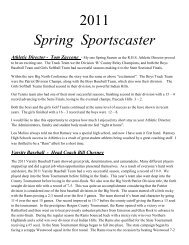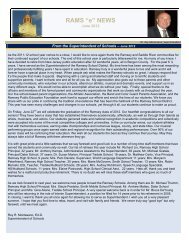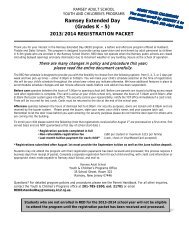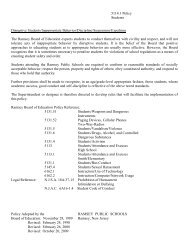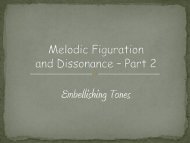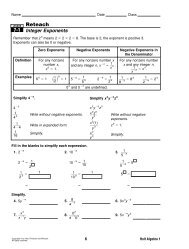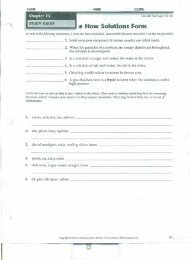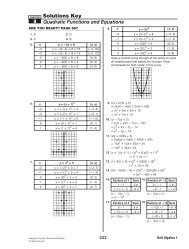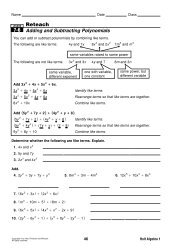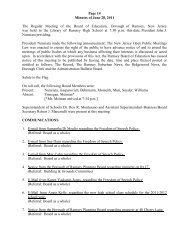Pre-Algebra Chapter 6 - Ramsey School District
Pre-Algebra Chapter 6 - Ramsey School District
Pre-Algebra Chapter 6 - Ramsey School District
Create successful ePaper yourself
Turn your PDF publications into a flip-book with our unique Google optimized e-Paper software.
A Follow-Up of Lesson 6-9<br />
Probability Simulation<br />
A random number generator can simulate a probability experiment. From the<br />
simulation, you can calculate experimental probabilities. Repeating a simulation<br />
may result in different probabilities since the numbers generated are different<br />
each time.<br />
Example<br />
Generate 30 random numbers from 1 to 6, simulating 30 rolls<br />
of a number cube.<br />
• Access the random number generator.<br />
• Enter 1 as a lower bound and 6 as an upper bound for<br />
30 trials.<br />
KEYSTROKES: 5 1 , 6 , 30 ) ENTER<br />
A set of 30 numbers ranging from 1 to 6 appears. Use the<br />
right arrow key to see the next number in the set. Record all<br />
30 numbers, as a column, on a separate sheet of paper.<br />
Exercises<br />
1. Record how often each number on the number cube appeared.<br />
a. Find the experimental probability of each number.<br />
b. Compare the experimental probabilities with the theoretical probabilities.<br />
2. Repeat the simulation of rolling a number cube 30 times. Record this second<br />
set of numbers in a column next to the first set of numbers. Each pair of<br />
30 numbers represents a roll of two number cubes. Find the sum for each of<br />
the 30 pairs of rolls.<br />
a. Find the experimental probability of each sum.<br />
b. Compare the experimental probability with the theoretical probabilities.<br />
3. Design an experiment to simulate 30 spins of a spinner that has equal<br />
sections colored red, white, and blue.<br />
a. Find the experimental probability of each color.<br />
b. Compare the experimental probabilities with the theoretical probabilities.<br />
4. Suppose you play a game where there are three containers, each with ten<br />
balls numbered 0 to 9. Pick three numbers and then use the random number<br />
generator to simulate the game. Score 2 points if one number matches,<br />
16 points if two numbers match, and 32 points if all three numbers match.<br />
Note: numbers can appear more than once.<br />
a. Play the game if the order of your numbers does not matter. Total your<br />
score for 10 simulations.<br />
b. Now play the game if the order of the numbers does matter. Total your<br />
score for 10 simulations.<br />
c. With which game rules did you score more points?<br />
www.pre-alg.com/other_calculator_keystrokes<br />
Investigating Slope-Intercept Form 315<br />
Graphing Calculator Investigation Probability Simulation 315



